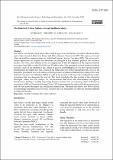| dc.contributor.author | Ó Briain, Diarmuid | |
| dc.contributor.author | Denieffe, David | |
| dc.contributor.author | Okello, Dorothy | |
| dc.contributor.author | Kavanagh, Yvonne | |
| dc.date.accessioned | 2022-10-04T13:00:28Z | |
| dc.date.available | 2022-10-04T13:00:28Z | |
| dc.date.issued | 2020 | |
| dc.identifier.citation | O’Briain, D., Denieffe, D., Okello, D., & Kavanagh, Y. (2020). The Internet in East Africa, a mixed methods study. East African Journal of Science, Technology and Innovation, 2(1). https://doi.org/10.37425/eajsti.v2i1.193 | en_US |
| dc.identifier.uri | http://research.thea.ie/handle/20.500.12065/4062 | |
| dc.description.abstract | East Africa was the last major area of the world to gain access to the Internet when submarine fibre-optic cables landed at Mombasa, Kenya and Dar-es-Salaam, Tanzania in 2009. The region previously relied on satellite communications to individual Internet Service Providers (ISP). This presented a unique opportunity to acquire and document the thoughts of key business, political and technical leaders who were, and continue to be, an integral part of the development of the regional Internet ecosystem from 2009, via the SEACOM and TEAMS cables. This prompted a mixed methods political economy study of the Internet in East Africa to gain an understanding of why the regional Internet infrastructure developed as it did, a vision of the future direction of the regional Internet, a view of the disruptive potential of new networking technologies such as Software Defined Networking (SDN) and Network Functions Virtualisation (NFV) as well as the growth of the Internet's multinational online companies that now dominate the Internet. The study concludes that the landing of the submarine fibre-optic cables was the catalyst for improvements that drove the development of regional infrastructure leading to rapidly improving Internet services such as streaming video facilitated by investment in ISP and Internet eXchange Points (IXP) improvements through mobile phone generations and roll-outs across the region have facilitated citizen access. The study also shows that fibre will play an increasingly important role; however, wireless that will remain the key delivery Internet platform over the next decade. | en_US |
| dc.format | application/pdf | en_US |
| dc.publisher | East African Journal of Science, Technology and Innovation | en_US |
| dc.rights | Attribution-NonCommercial-ShareAlike 4.0 International | * |
| dc.rights.uri | http://creativecommons.org/licenses/by-nc-sa/4.0/ | * |
| dc.subject | Fiber Optics | en_US |
| dc.subject | Internet | en_US |
| dc.subject | East Africa | en_US |
| dc.title | The Internet in East Africa: a mixed methods study | en_US |
| dc.type | info:eu-repo/semantics/article | en_US |
| dc.contributor.affiliation | engCORE, Institute of Technology Carlow, Ireland | en_US |
| dc.contributor.affiliation | engCORE, Institute of Technology Carlow, Ireland | en_US |
| dc.contributor.affiliation | netLabs!UG, Makerere University, Kamlala, Uganda | en_US |
| dc.contributor.affiliation | engCORE, Institute of Technology Carlow, Ireland | en_US |
| dc.description.peerreview | yes | en_US |
| dc.identifier.doi | https://doi.org/10.37425/eajsti.v2i1.193 | en_US |
| dc.identifier.issue | 1 | en_US |
| dc.identifier.orcid | https://orcid.org/0000-0001-5802-0571 | |
| dc.identifier.orcid | https://orcid.org/0000-0002-8339-787X | |
| dc.identifier.url | https://eajsti.org/index.php/EAJSTI/article/view/193 | en_US |
| dc.identifier.volume | 2 | en_US |
| dc.rights.accessrights | info:eu-repo/semantics/openAccess | en_US |
| dc.subject.department | engCORE, Institute of Technology Carlow | en_US |
| dc.type.version | info:eu-repo/semantics/publishedVersion | en_US |
| dc.audience | Researchers, students, Engineers, Technologists | en_US |


